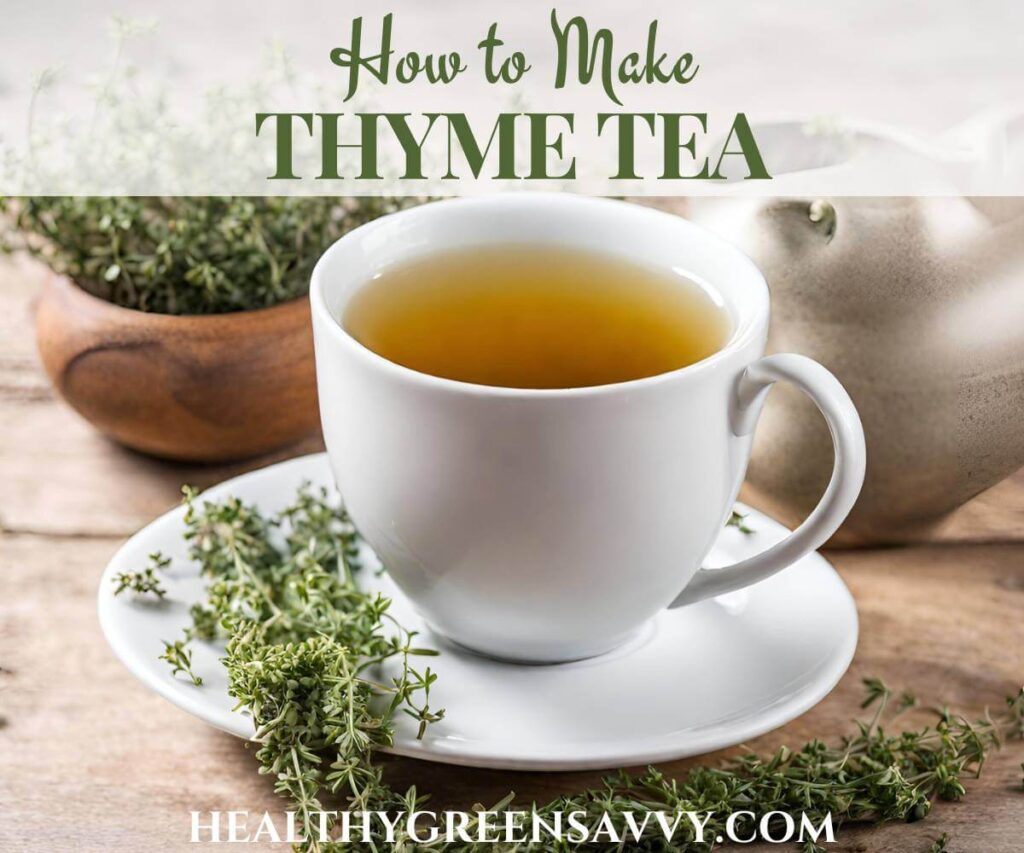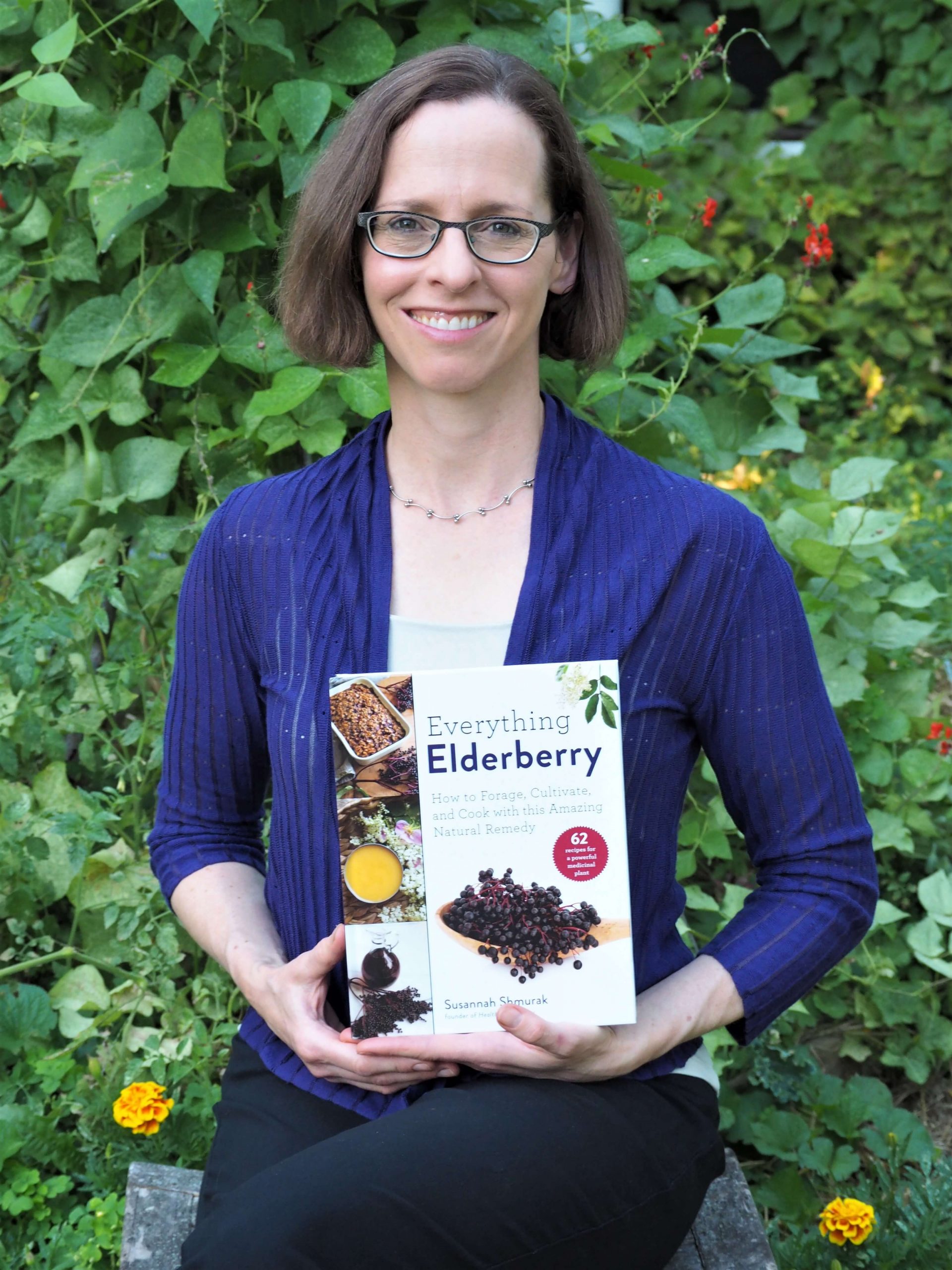Last Updated on February 14, 2024
Do you love trying out new herbs for tea? If you’re looking for something different, try this easy thyme tea recipe. Here’s how to make tea from fresh or dried thyme.

Do you drink a lot of herbal tea, too? If you’ve had enough of mint, lemon balm, ginger tea, and the like, here’s a new one for you: Thyme tea.
THYME IN TEA? REALLY?
I’ll admit, I was skeptical about the appeal of thyme tea. Thyme is a pretty strong-tasting herb that I love to use to season soups, like my go-to vegan white bean soup and homemade pea soup. But in tea?
Now, thyme is also a beloved medicinal herb, especially for colds and flu. One of the best herbs for cough, thyme can be used to quell throat irritation in broth or infused in honey, or steeped in hot water.
Still, I wasn’t sure about adding it to the long list of herbal teas I enjoy on a regular basis.
But ever-curious, I wanted to try it anyhow. If you’ve ever wished when you were making yet another fruity tea like elderberry or a grassy tea like nettle or oatstraw that you had something with another flavor profile altogether, thyme tea is worth exploring.
Yes, tea made from thyme leaves has that signature thyme flavor, but I promise it isn’t as weird as it sounds. And if you’ve got a sore throat or respiratory illness, knocking back a few cups of this stuff may help.
I also highly recommend pine needle tea and tea made from creeping Charlie for helping with cold symptoms. Odd as it may sound, tea made from creeping Charlie (known as ground ivy by those who recognize its medicinal value) is the thing that helps me feel better when I’ve got that exhausted feeling that comes with a bad cold.
But it’s not something I’d recommend for flavor. But thyme tea? That you could drink just because it tastes good.
BENEFITS OF THYME TEA
Thyme is a potent medicinal herb used often for colds and flu. It’s especially helpful for coughs, as it’s an expectorant and antitussive as well as soothing to sore throats.
Thyme is also considered a nervine and useful for promoting healthy digestion, among other medicinal uses.
You can read more about the benefits of thyme at the Herbal Academy
WebMD cautions that thyme might slow the blood’s ability to clot and shouldn’t be consumed 2 weeks prior to surgery. It also may have estrogenic effects and shouldn’t be used by those with hormone-sensitive conditions.
Thyme has been used as an herb to bring on menstruation, so it’s generally advised to avoid using thyme medicinally during pregnancy.

WHERE TO GET THYME FOR TEA
I highly recommend growing your own thyme. It’s not only a fantastic culinary and medicinal herb, it’s also a superb drought-tolerant ground cover that spreads nicely and makes a great alternative to grass if you’re trying to make your landscaping more eco-friendly.
Here are a bunch more ground cover herbs to consider planting in your yard.
If you grow thyme, you have a ready source of this lovely herb throughout the growing season, and you have choices of variety that you wouldn’t if you relied on purchased dried thyme. Plus drying thyme is a snap and means you can have plenty of homegrown thyme on hand throughout the winter as well.
I have a lot of lemon thyme growing in my yard, and it’s exceptionally nice as tea. The lemon flavor tends to be more prominent than the thyme flavor, so if you’re hesitating about thyme tea’s flavor, lemon thyme might be worth trying first.
Of course, you can also simply buy thyme for your tea. If you’re not growing your own, I recommend buying dried thyme, as fresh herbs are generally so absurdly expensive and come packaged in a ridiculous amount of plastic.
If you don’t already have dried thyme in your spice cabinet, here’s a money-saving zero waste tip: Rather than purchase a bottle of thyme, bring an empty bottle to the bulk section of a natural foods store. While a new bottle of organic dried thyme might run you $4 or more, you can fill your own bottle for a little over a dollar.

In addition to saving you money and cutting packaging waste, you can buy just what you need and not have a bunch of your purchase lose potency in the back of your spice cabinet if you don’t use it all right away.
If you don’t have access to bulk herbs, generally Vitacost is the least expensive way to get herbs (and loads of great organic groceries and household products). A small bottle of organic thyme is just a few dollars if you shop during one of Vitacost’s many excellent sales. (Don’t forget to use Rakuten’s browser extension for cash back. If you don’t have it already, you can join and get a $30 bonus using this link.)
USEFUL TOOLS FOR MAKING THYME TEA
All you need to make thyme tea is thyme and hot water, but some helpful tools can take your tea up a notch.
I highly recommend getting a quality water filter. Most water supplies contain numerous unregulated chemicals you don’t want in anything you drink. The water quality report you get from your municipality measures just a few contaminants, and most standard water filters do little to remove the many pharmaceuticals and other pollutants common in most water supplies.
Find out more about what you need to know to select an effective water filter. Note that most popular filters don’t filter out most of these chemicals of concern. After a great deal of research, this is the filter we chose.
Some other tools to help with your tea-making:
FLAVOR TIPS AND VARIATIONS
To minimize bitterness, I recommend using less dried thyme and steeping it for about 5 minutes. If the tea is too strong for your tastes, you can try diluting it with more water.
Try drinking tea without sweetening and see if you like it. I don’t sweeten any of my herbal teas, preferring to late the flavor of the herbs shine through and saving my sugar budget for healthy desserts.
Thyme also works together with other flavors. Some variations to try:
- Additional herbs like sage, ginger, or mint add variety and other medicinal benefits. Orange peels are another great choice, adding flavor and beneficial nutrients with something you might normally throw out.
- Citrus fruits, like lemon and orange can be added after steeping
- Combine with other kinds of tea, such as green, white, or black to shake up your typical tea routine
STORING AND PRESERVING THYME TEA
To store your tea, strain the thyme, let the tea cool, and refrigerate it in an airtight container.
If you’ve made a lot of tea, freezing it in ice cube trays offers a convenient way to preserve it for later use. Once frozen, transfer the thyme tea cubes to a freezer bag for easy storage. When ready to enjoy, you can allow them to thaw in the refrigerator or out on the counter. To enjoy as an iced tea, simply let them melt. To consume as a hot beverage, heat the defrosted tea over low heat on the stovetop.
HOW TO MAKE THYME TEA FROM FRESH OR DRIED THYME
There’s a fair amount of wiggle room with the amounts of herb to use in herbal teas. Some people prefer stronger infusions, while others like a milder flavor. I generally err on the side of ading too much herb, as it’s easy to dilute with additional water if you want to.
–>Top tip for easier tea making: If you’re using sprigs, don’t bother stripping thyme leaves! Thyme leaves are time-consuming to remove, and it’s really not necessary. You can just submerge fresh or dry sprigs of thyme in your teapot or cup.

How to Make Thyme Tea with Fresh or Dried Thyme
Tasty thyme tea is easy to make from either fresh or dried thyme. It's also a great medicinal tea to keep on hand.
Ingredients
- 2 teaspoons dried thyme or about 6 fresh thyme sprigs
- 2 cups freshly boiled filtered water
Instructions
To make tea from fresh thyme:
- Harvest thyme in the late morning after the dew has dried.
- You'll need about 3 thyme sprigs per 8 ounces of water. You can place them directly in your cup or teapot without stripping the leaves.
- Rinse and place sprigs in a large teapot, saucepan, or mason jar.
- Cover with boiled filtered water and allow to steep, covered, for at least 5 minutes and up to 4 hours. Longer brew times yield a more strongly-flavored tea.
- Strain and refrigerate what you won't drink immediately.
To make tea from dried thyme:
- To brew tea from dried thyme, use 1 heaping teaspoon per cup of water. To make 3 cups, use 3 teaspoons dried thyme with 3 cups freshly boiled water. If you have dried thyme sprigs, use 3 per cup of water.
- Place thyme in a large teapot or mason jar. Cover with boiled filtered water and allow to steep, covered, for at least 5 minutes and up to 4 hours.
- After steeping, strain the thyme leaves from the water using a fine-mesh sieve or a tea strainer.
- Drink immediately, refrigerating any leftover tea.
Notes
You can sweeten the infusion with honey or add a slice of lemon if desired.
Nutrition Information:
Yield: 2 Serving Size: 1Amount Per Serving: Calories: 6Total Fat: 0gSaturated Fat: 0gTrans Fat: 0gUnsaturated Fat: 0gCholesterol: 0mgSodium: 10mgCarbohydrates: 1gFiber: 1gSugar: 0gProtein: 0g
Nutritional information was auto-generated based on serving size, number of servings, and typical information for the ingredients listed. To obtain the most accurate representation of the nutritional information in a given recipe, please calculate the nutritional information with the actual ingredients and amounts used, using your preferred nutrition calculator. Under no circumstances shall this website or author be responsible for any loss or damage resulting for your reliance on the given nutritional information. You are solely responsible for ensuring that any nutritional information provided is accurate and complete.
–> If you love trying new herbal teas, be sure to check out some of these other tea recipes, using herbs you can grow or forage:
Or try learning how to create your own herbal tea blends.
If you try making this thyme tea recipe, please leave a comment to let me know what you thought of it!
Save this info on how to make thyme tea for later!

Disclaimer: I’m a health enthusiast, not a medical professional. Content on this website is intended for informational purposes only and is not meant to provide personalized medical advice. I draw on numerous health sources, some of which are linked above. Please consult them for more information and a licensed professional for personalized recommendations.

Susannah is a proud garden geek and energy nerd who loves healthy food and natural remedies. Her work has appeared in Mother Earth Living, Ensia, Northern Gardener, Sierra, and on numerous websites. Her first book, Everything Elderberry, released in September 2020 and has been a #1 new release in holistic medicine, naturopathy, herb gardening, and other categories. Find out more and grab your copy here.




 Hi, I'm Susannah, a garden geek, energy nerd, and fan of healthy food and natural remedies. Need some simple, practical solutions for living healthier and greener? You've come to the right place! More about me and my green projects
Hi, I'm Susannah, a garden geek, energy nerd, and fan of healthy food and natural remedies. Need some simple, practical solutions for living healthier and greener? You've come to the right place! More about me and my green projects